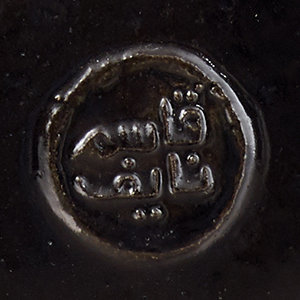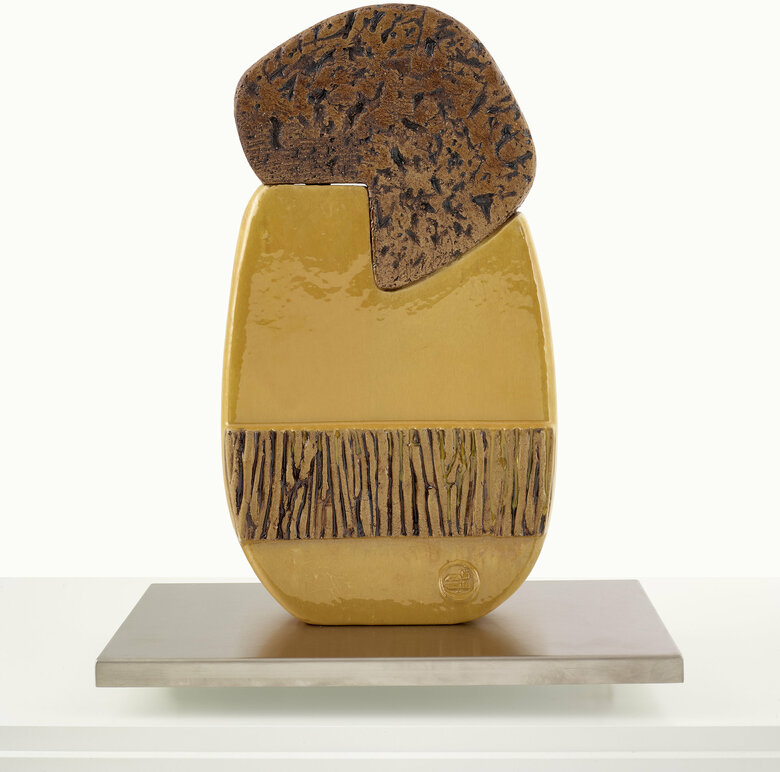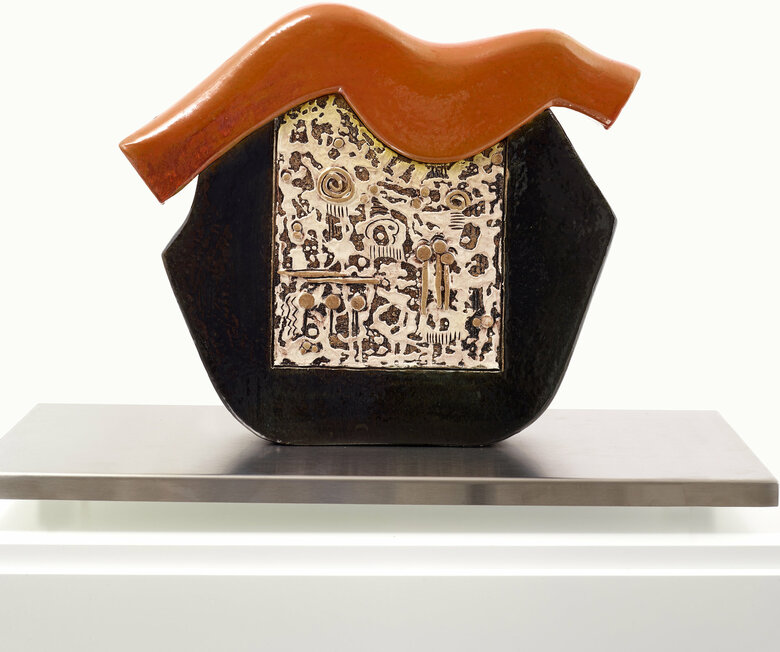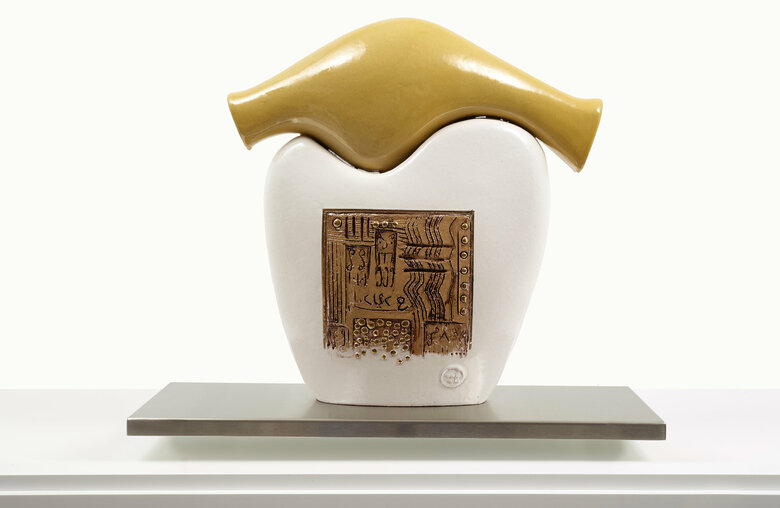Written by Mysa Kafil-Hussain Born in Iraq in 1963, Kasim Nayef came from a working class family with little knowledge or experience in art. He enjoyed a range of artistic mediums, including...


KASIM NAYEF, Iraq (1963)
Bio
Written by Mysa Kafil-Hussain
Born in Iraq in 1963, Kasim Nayef came from a working class family with little knowledge or experience in art. He enjoyed a range of artistic mediums, including painting, and would make sculptures from clay in his spare time, also participating in drawing exhibitions during his school years.[1] These hobbies and interests during his youth prompted him to consider furthering his knowledge and to allow the natural artist within him to flourish. Nayef enrolled into the College of Fine Arts at the University of Baghdad in the mid-1980s (formerly known as the Academy of Fine Arts[2]), focusing on ceramic art.[3]
Whilst studying, Nayef was taken under the wing of renowned Iraqi ceramic artist, Saad Shaker, a professor at the time. Working with Shaker in his studio, Nayef learnt a great deal about how traditional porcelain formed the basis for modern ceramics, transforming the material into an exciting contemporary artform. Shaker passed on his experience, giving Nayef the skills, tools and inspiration to pursue his experimental work further.[4]
“I worked with him in his studio and he presented me with all of the information he possesses on a plate of gold, and I owe this man a lot.”
Kasim Nayef on his professor and mentor, Saad Shaker[5]
Having been influenced by Shaker’s style for many years, Nayef gradually found his own unique aesthetic and artistic character. He graduated in 1988, and began participating regularly in local and national exhibitions, including the Baghdad International Festival of Art in 1988. He also won several awards including a number of first place prizes.
Nayef’s personal style is largely derived from aspects of Iraqi heritage, ancient civilisation and the local environment, taking immense inspiration from the natural world with its “beauty, trees, rocks and stars.”[6] There are four ceramic sculptures by Nayef in the Dalloul Collection, all of which are untitled and from 2016, and all of which adhere to the styles and techniques which he has become known for. The four pieces are raised, standing structures which combine a range of earthy colours and textures, layered one on top of the other whilst allowing for space to focus on each individual element. Nayef often uses the shapes of animals or other aspects of the natural world to form the foundations of the work, although his immediate references are not obvious here. Nevertheless, the fluidity and serenity exuded from the curves, complemented by the formation of the blocks as well as the juxtaposition of rugged and smooth surfaces create an abstract tactual window into a enchanting environment.
Being an artist in contemporary Iraq has been a struggle for a range of reasons, but ceramic art in particular has often struggled to shine its light in a world, which not only regularly focuses on other artforms, but also prioritizes art from countries and regions with greater stability and opportunity. In an interview with Sarah Hassan Musa in 2014, Nayef discussed the unique style and quality of Iraqi ceramic art, commenting that Iraqi ceramics sought to liberate the art of ceramics from its traditional roots, despite only a handful of Iraqi practitioners reaching global notoriety.[7] When discussing the future of ceramic art in the country, Nayef claimed that it was a completely neglected artistic genre and that more needed to be done to bring ceramic artists together across the country and across the world, aside from the personal efforts from individual artists and professors.[8] Nayef was one of the many artists who was not only committed to his chosen field, but also committed to staying in Iraq to pursue it and pass on his knowledge to younger generations. He teaches ceramic art at the College of Fine Arts in Baghdad, where he has worked now for many years. He also continues to produce ceramic artworks at his studio in Baghdad, and maintains a high local reputation for his skills in creating pieces with artistic beauty and maturity, engineering accuracy and a deep connection to both the rich local environment and to the endless aesthetic possibilities found within Iraqi heritage.[9]
[1] Sarah Hassan Musa (2014), الفنان قاسم نايف جواد: الخزاف العراقي يظل متقدما على الخزافين العرب, n.pag
[2] College of Fine Arts (n.d.), نشأة كلية الفنون الجميلة, n.pag
[3] Faisal Abdul Hassan (2013), رؤيا جمالية ومعمارية في أعمال خزّافين عراقيين, n.pag
[4] Musa (2014), n.pag
[5] Musa (2014), n.pag
[6] Musa (2014), n.pag
[7] Musa (2014), n.pag
[8] Musa (2014), n.pag
[9] Hassan (2013), n.pag
Sources
Abdul Hassan, Faisal (2013). “ رؤيا جمالية ومعمارية في أعمال خزّافين عراقيين”, In Azzaman.com. Accessed August 2020. https://www.azzaman.com/%D8%B1%D8%A4%D9%8A%D8%A7-%D8%AC%D9%85%D8%A7%D9%84%D9%8A%D8%A9-%D9%88%D9%85%D8%B9%D9%85%D8%A7%D8%B1%D9%8A%D8%A9-%D9%81%D9%8A-%D8%A3%D8%B9%D9%85%D8%A7%D9%84-%D8%AE%D8%B2%D9%91%D8%A7%D9%81%D9%8A%D9%86/
College of Fine Arts, University of Baghdad (n.d.). “ نشأة كلية الفنون الجميلة”, In Cofarts.uobaghdad.edu.iq. Accessed August 2020. http://cofarts.uobaghdad.edu.iq/?page_id=15070
Musa, Sarah Hassan (2014). “الفنان قاسم نايف جواد: الخزاف العراقي يظل متقدما على الخزافين العرب”, In AlTaakhiPress.com. Accessed August 2020. http://altaakhipress.com/printart.php?art=44874
Naef, Kassim (2017). “الخزف العراقي والخزاف قاسم نايف في برنامج روائع ورموز قناة بلادي”, Youtube, https://www.youtube.com/watch?v=14s0Ja5zZ6E. Accessed August 2020.
Tashkeel (2014). “تشكيل الخزاف قاسم نايف تقديم قاسم محسن مونتاج فرقد الماجدي .اخراج ولاء الصافندي”, YouTube, https://www.youtube.com/watch?v=SwTGf7C2QlY. Accessed August 2020.
Press
صحيفة التآخي - الفنان قاسم نايف جواد- ا... العراقي يظل متقدما على الخزافين العرب.pdf
صحيفة التآخي - الفنان قاسم نايف جواد_ الخزاف العراقي يظل متقدما على الخزافين العرب.pdf
قاسم نايف .... البحث عن مسارات مغايرة .في فن الخزف...-محمد العبيدي (العراق).pdf
رؤيا جمالية ومعمارية في أعمال خزّافين عراقيين AZZAMAN الزمان.pdf
KASIMNAYEF_ALTAAKHI.PDF
قاسم نايف .... البحث عن مسارات مغايرة .في فن الخزف.pdf
MJAF_Volume 3_Issue العدد 10 (2)_Pages 721-732.pdf
106225.pdf
خزافون عراقيون ابتكارات فنية تعيد قراءة ثوابتها.pdf
محمد العبيدي - قاسم نايف .... البحث عن مسارات مغايرة .في فن الخزف....pdf
KASIM NAYEF Artwork
Become a Member
Join us in our endless discovery of modern and contemporary Arab art
Become a Member
Get updates from DAF
Follow Artists
Save your favourite Artworks
Share your perspectives on Artworks
Be part of our community
It's Free!
We value your privacy
TermsCookiesPrivacy Policies
Become a Member
Get updates from DAF
Follow Artists
Save your favourite Artworks
Share your perspectives on Artworks
Be part of our community
It's Free!
We value your privacy
TermsCookiesPrivacy Policies
Become a Member
Get updates from DAF
Follow Artists
Save your favourite Artworks
Share your perspectives on Artworks
Be part of our community
It's Free!
We value your privacy
TermsCookiesPrivacy Policies
Welcome to the Dalloul Art Foundation
Thank you for joining our community
If you have entered your email to become a member of the Dalloul Art Foundation, please click the button below to confirm your email and agree to our Terms, Cookie & Privacy policies.
We value your privacy, see how
Become a Member
Get updates from DAF
Follow Artists
Save your favourite Artworks
Share your perspectives on Artworks
Be part of our community
It's Free!
We value your privacy
TermsCookiesPrivacy Policies










